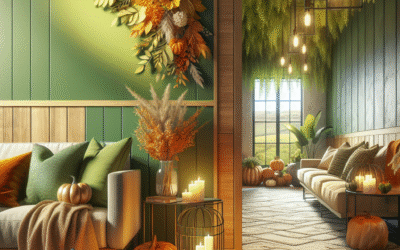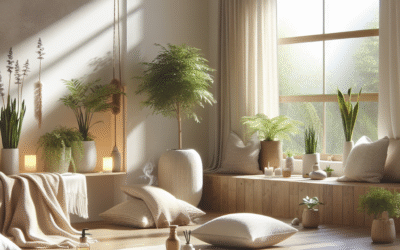
Looking to elevate your living space without burning a hole in your wallet? Wall tapestries can be the perfect solution. They’re not only visually captivating but also functional and budget-friendly! In this article, you’ll uncover effective DIY projects for wall tapestries that will transform your space. We’ll guide you through techniques, materials, and helpful tips to ensure your tapestry-making journey is successful and enjoyable. By the end, you’ll have the skills to create beautiful tapestries that reflect your unique style.
Let’s dive into the world of DIY wall tapestries and discover how to bring your home decor vision to life!
Understanding Wall Tapestries
Wall tapestries have been used for centuries but have recently gained popularity as an affordable art option. These fabric pieces can serve as decorative elements or even as sound diffusers in a room. The best part? You don’t need a huge budget to create one! Let’s explore the definition, primary benefits, and types of tapestries.
What is a Wall Tapestry?
A wall tapestry is a piece of fabric art made by weaving or embroidery to create intricate designs and patterns. Historically, they were used to depict significant events or display wealth. Today, they serve as versatile decor items that can suit any style, from bohemian to modern minimalist.
Benefits of Using Tapestries in Your Home
- Affordability: Tapestries can be made economically with readily available materials.
- Versatility: Available in various styles, colors, and patterns, they suit different preferences.
- Sound Absorption: They can help dampen sounds within your environment.
- Easy Installation: No need for complicated framing; they can be hung using rods, nails, or adhesive clips.
Materials for DIY Tapestries
When embarking on a DIY tapestry project, the choice of materials is crucial. Below are commonly used materials that won’t stretch your budget:
Fabric Choices
Opt for affordable fabric options like cotton, burlap, or even old bed sheets. These materials are cost-effective and readily available.
Add-Ons and Supplies
You’ll need some essential supplies such as:
- Fabric glue or a sewing kit
- Scissors
- Rods or wooden dowels for hanging
- Pins or clips to hold pieces in place
Step-by-Step Guide to Creating Your Tapestry
Ready to get started? Follow this straightforward guide to create your stunning tapestry.
Step 1: Conceptualizing Your Design
Before you start, sketch or visualize your tapestry design. Consider themes, colors, and patterns that will enhance your space.
Step 2: Gathering Materials
Collect all needed materials as mentioned above. Don’t hesitate to utilize scraps from previous projects!
Step 3: Cutting and Preparing Fabric
Cut your fabric into the desired shape and size. Ideally, your cuts should be clean and uniform to achieve a finished look.
Step 4: Designing the Tapestry
This is where creativity shines! Use fabric paint, stencils, or even embroidery to create intricate designs. Attach embellishments such as beads or fringe for added texture.
Step 5: Assembling and Hanging
Once your design is complete, let it dry. Then, attach it to a rod for easy hanging. Choose a spot that enhances your décor!
Design Inspirations for Tapestries
Your tapestry can reflect your personality or the mood of your room. Here are a few inspiring ideas:
Nature Themes
Consider creating a tapestry featuring floral designs or landscapes that evoke the beauty of the natural world.
Abstract Art
Play with colors and shapes for an abstract design that can easily serve as a conversation starter.
Cultural Patterns
Incorporate cultural motifs or symbols that resonate with your heritage or interests, offering a unique artistic touch.
Maintenance and Care for Your Tapestries
To ensure your tapestry lasts, proper maintenance is essential. Here are a few tips:
Cleaning Techniques
Regular dusting and occasional washing (if fabric permits) will keep your tapestry looking fresh. Always check care labels first.
Storage Tips
When not in use, roll your tapestry instead of folding it to prevent creases. Store in a cool, dry place.
How to Enhance Your Space with Tapestries
Now that you’ve created your tapestry, let’s enhance your space. Here are a few pointers:
Layering with Other Decor
Combine your tapestry with other decor such as plants, mirrors, or paintings to create a cohesive look.
Harmonizing Colors
Ensure that the colors of your tapestry complement the existing color scheme of your space for a balanced aesthetic.
DIY Tapestry Mistakes to Avoid
Every DIY project comes with learning curves. Here’s what to steer clear of:
Overcomplicating the Design
Keep designs simple, especially for first-time crafters. Complexity can lead to frustration.
Choosing Poor Quality Materials
Invest in decent quality fabric and supplies to ensure durability in your tapestry.
Frequently Asked Questions
Can I use any fabric for my tapestry?
While you can use various fabrics, natural fibers like cotton or linen work best for durability and aesthetic appeal.
How do I hang my tapestry without damaging the wall?
Use removable adhesive hooks or clips designed for hanging fabric without leaving marks.
What are the best designs for a bohemian-style tapestry?
Look for designs featuring mandalas, tribal patterns, or nature-inspired motifs often found in bohemian decor.
How can I incorporate tape into my tapestry?
Use painter’s tape to create clean lines and shapes when designing your tapestry for added visual clarity.
Is it possible to dye my own fabric for tapestries?
Yes! Fabric dyeing can add a personalized touch and unique color palette to your tapestry.
Conclusion
DIY budget-friendly wall tapestries can redefine your space and express your creativity. By following the strategies outlined in this article, you’ll not only enhance your decor but also gain a sense of accomplishment. Start today and create a tapestry that showcases your unique style. Happy crafting!
For more insights on home decor and DIY projects, check out our other articles tailored to your creative needs!
Content Disclaimer
The information provided in this article is for educational purposes only. For specific design-related questions, consult a professional interior designer. Always be cautious with materials and methods to ensure safety and efficacy in your projects.
Categories
- Accent Walls & Ceilings (61)
- Art Curation & Gallery (62)
- Bedding Style Trends (68)
- Bedroom Makeover (81)
- Bohemian & Eclectic Styles (58)
- DIY & Budget-Friendly Decor (64)
- Eco-Friendly Design (62)
- Furniture Care (71)
- Home Decor & Design Ideas (162)
- Home Wellness Spaces (59)
- Integrated Outdoor Living (67)
- Japandi Style (61)
- Kids and Nursery Decor (59)
- Living Room Decor (79)
- Mix & Match Techniques (73)
- Modern & Contemporary Design (66)
- Rug Sizing & Placement (73)
- Scandinavian Design Inspiration (20)
- Seasonal Home Decor (79)
- Small Space Solutions (73)
- Wall Art & Painting Tips (77)
Recent Comments
Archives
Product Gallery
-
Large Area Green Rugs for Bedroom Nordic Living Room Decoration Shaped Carpet Irregular Plush Lounge Rug Home Thick Washable Mat
Rated 5.00 out of 5$36.00 – $225.00Price range: $36.00 through $225.00 -
Nordic Style Rugs for Bedroom Morandi Living Room Decoration Carpet Large Area Geometry Lounge Rug Home Cloakroom Non-slip Mat
Rated 5.00 out of 5$26.00 – $388.00Price range: $26.00 through $388.00 -
Irregular Shapes Living Room Decoration Carpet Modern Style Rugs for Bedroom Home Thicken Plush Rug Fluffy Soft Lounge Floor Mat
Rated 4.83 out of 5$37.00 – $226.00Price range: $37.00 through $226.00














